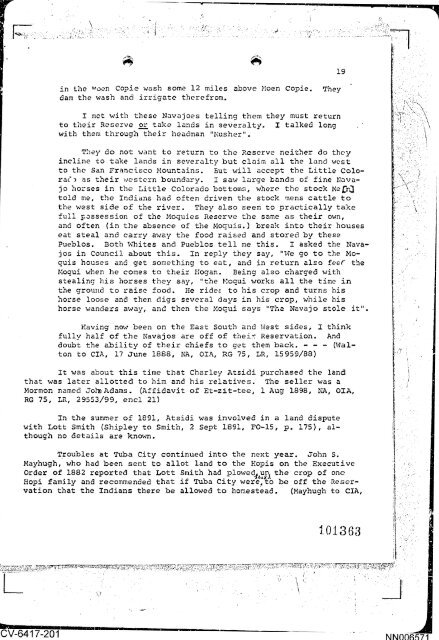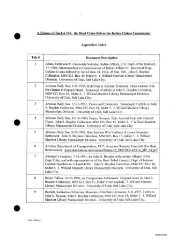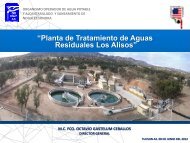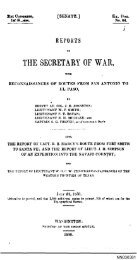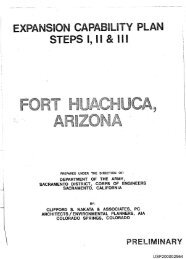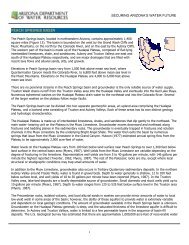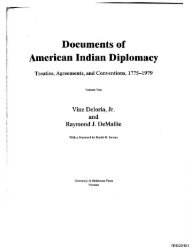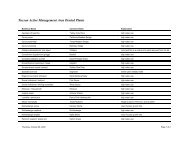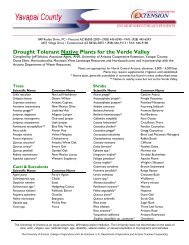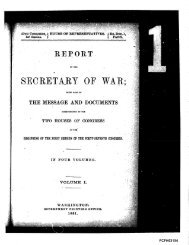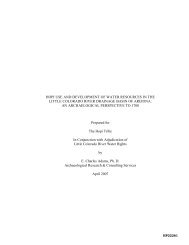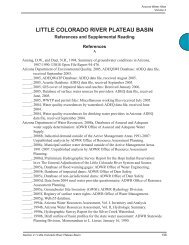By David Brugge - Arizona Department of Water Resources
By David Brugge - Arizona Department of Water Resources
By David Brugge - Arizona Department of Water Resources
You also want an ePaper? Increase the reach of your titles
YUMPU automatically turns print PDFs into web optimized ePapers that Google loves.
in the W w n Copie wash somc 12 miles above Noen Copie. They<br />
dam the wash and irrigate therefrom.<br />
I mct with these Navajocs telling them they must return<br />
to their Reserve or take lands in severalty. I talked long<br />
with them through their headman "&usher".<br />
Th2y do not want to return to the Reserve neit3er do thcy<br />
incline to take lands in severalty but claim all the land wcst<br />
to the San Francisco blountains. but will accept the Little Colo-<br />
rai3 as their western boundary. I saw large bands <strong>of</strong> fine Nava-<br />
jo horses in the Little Colorado bottoms, wherr the stock # e m<br />
told me, the Indians had <strong>of</strong>ten driven the stock mens cattle to<br />
the west side <strong>of</strong> the river. They also seem to practically take<br />
full psssession <strong>of</strong> the Moquies Reserve the same as their own,<br />
and <strong>of</strong>ten (in the absence <strong>of</strong> the hioquis.) break into their houses<br />
eat steal and carry away the food raised and stored by these<br />
Pueblos. Both Whites and Pueblos tell me this. I asked the Nava-<br />
jos in Council. about this. In reply they say, "We go to the Mo-<br />
quis houses and get something to eat, and in return also feeF the<br />
Moqui when he comes to their Piogan. Being also charged with<br />
stealing his horses they say, "the Moqui works all the time in<br />
the ground to raise food. He rider to his crop and turns his<br />
Sorse loose and then digs several days in his crop, while his<br />
horse wanders away, and then the Noqui says "The Navajo stole it".<br />
Having now been on the East South and West sides, I think<br />
fully half <strong>of</strong> the Navajos are <strong>of</strong>f <strong>of</strong> their Reservation. And<br />
doubt the &ility <strong>of</strong> their chiefs to get them back. - - - (Wal-<br />
ton to CIA, 17 June 1868, NA, OIA, RG 75, LR, 15959/88)<br />
It was about this time that Charley Atsidi purchased the land<br />
that was later allotted to him and his relatives. The seller was a<br />
Mormon named JohAdains. (Affidavit <strong>of</strong> Et-zit-tee, 1 Aug 1898, XA, OIA,<br />
RG 75, L3, 29553/99, encl 21)<br />
In the sumner <strong>of</strong> 1891, Atsidi was involved in a land dispute<br />
with Lott Smith (Shipley to Smith, 2 SepC 1891, FO-15, p. 175). al-<br />
though no details are known.<br />
Troubles at Tuba City continued into the next year. John S.<br />
Wayhugh, who had been sent to allot land to the Bopis on the Executive<br />
Order <strong>of</strong> 1882 reported that Lott Smith had ploweddeyL t he crop <strong>of</strong> one<br />
Hopi family and recommended that if Tuba City were,%o be <strong>of</strong>f the Ressr-<br />
vation that the Indians there be allowed to homestead, (Mayhugh to CIA,


